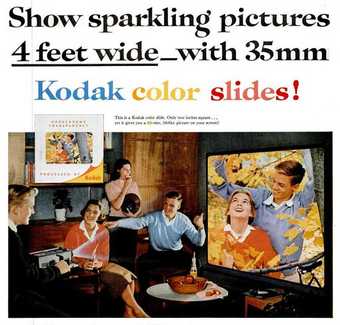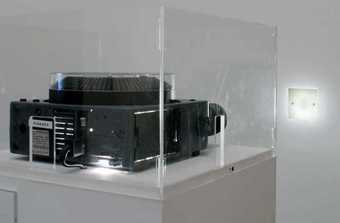‘Slide’ commonly refers to a 35 mm photographic positive image comprising chromogenic dyes on a transparent base held inside a plastic or card mount. Without this mount, the transparent film material would not be able to ‘slide’ from one image to another inside a carousel or magazine when projected. In contrast to negative-based film, reversal film is photo-chemically processed as a positive image. In most Romance languages ‘slide’ is translated as diapositive: dia [Gr.] (through, between). Transparent breaks down into trans [Lat.] (beyond, across) and parere [Lat.] (to appear, be visible, be seen, etc.). All three terms: slide, transparency and dia describe an ephemeral presence, a state in which a picture is formed, lasts and disappears.1
The 35 mm slide transparency is a hybrid medium that belongs on a continuum between still photography and motion-picture film and combines qualities of both technologies. A slide is a high-resolution positive photograph that is exemplary in its accurate colour reproduction and versatility. A 35 mm slide can be magnified by a factor of 100 (from 35 mm to 3,500 mm) and still maintain a crisp and detailed projected image.

Kodak advertisement in LIFE, 5 October 1959, p.68
Kodak’s commercial slogan during the 1950s was: ‘For sparkling pictures big as life … Kodak 35mm colour slides’. During the 35 years of their popularity, from 1960s to the mid-1990s, 35 mm slides were a cheap and easy way to create high-quality projected images in a technological environment that offered few, if any, viable alternatives. Even if money were no object, no other medium could compete with the ability of slides to produce large-scale projected images of comparable excellence. Video technology, for example, could only produce a fraction of the quality. Alternative technologies such as 16 mm film involved a far more elaborate production process. The only other format that was readily available on a similar budget, without the need of professional post-production, was 8 mm film produced for the home movie market. Both 16 mm and 8 mm film are moving image media and hence produce a very different quality of image.
In its heyday processing costs for slides were relatively low and they were widely used in contexts ranging from domestic to commercial applications such as advertising, fashion and industry as well as academia and the arts.
Many art historians still refer to slide-based artworks as slide-tape. This term dates from the 1970s when magnetic audio-tapes in cassette format were used to store a tone that cued slide changes alongside the audio track or spoken word accompanying the images.
Artists began to explore media technologies in the early 1960s, a period which coincided with a radical shift in artist practice. Artists have both exploited slide technologies as a precise aesthetic medium and as a means of documenting more conceptual practice. Charles Harrison, in his paper Saving Images has also argued that slides suited the artistic debates of the period because they provided a means of creating sequences of images that were not object-based.
Slides, of course, offered a virtually infinite range of cheap pictures, easily accumulated. Their small size meant that they could be readily manipulated, while their transparency meant that they could be enlarged to the typical scale of paintings without the imposition of a lot of physical material.2
Slides had a ‘technical innocence’, having little history as an artistic medium but instead a practical association with documentation.3
Slides were used to capture performances, journeys and the lives of artists, as evidenced in works created by Nan Goldin (born 1953), Robert Smithson (1936–1973), Lothar Baumgarten (born 1944), David Tremlett (born 1945) or Paul McCarthy (born 1945). Artists such as Dan Graham (born 1942) and Smithson freely worked across media using the same set of images in slide projections, printed photographs that were framed and hung on a gallery wall, and print media in catalogues or magazines.
The use of slides to tell stories, in both simple and technically sophisticated, straightforward and ambiguous ways, has been exploited in the works of David Lamelas (born 1946) and James Coleman (born 1941) either in creating simple sequences of images or complex dissolves with audio accompaniment. Many of these early adopters and also a later generation of artists such as Armando Andrade Tudela (born 1975) and Hilary Lloyd (born 1964) used slides to create and display visually rich and beautiful images, exploiting the high-resolution photographic quality offered by the medium.
It may also be the case that in recent years artists have been drawn to this technology for the very reason that it is on the brink of obsolescence:
Today, no exhibition is complete without some form of bulky, obsolete technology – the gently clunking carousel of a slide projector or the whirring of an 8 mm or 16 mm film reel. The sudden attraction of ‘old media’ for contemporary artists in the late 1990s coincided with the rise of ‘new media’, particularly the introduction of the DVD in 1997.4
Whilst artists foreground the experience of the apparatus of slide technology to a greater or lesser degree, the position of the slide projector on a pedestal and the sound it creates when the slides change is tightly interwoven with our experience of these works. Though we appreciate that the equipment associated with slide technology possesses a sculptural presence, this is often entirely unintended and is simply a consequence of using this technology. Nevertheless, the carousel slide projector has become an iconic object and the distinction between the apparatus of 35 mm slide projection and a digital projection is therefore significant.

Ceal Floyer
Light Switch 1992–9
Installation view
© Ceal Floyer
Courtesy Lisson Gallery, London
